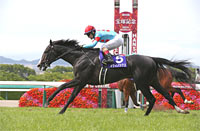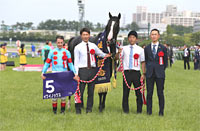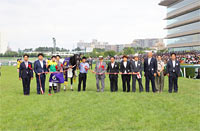Takarazuka Kinen (G1) - Data Analysis
No lack of surprise results in climax of the first-half racing program
Lys Gracieux secured her second G1 victory at the Takarazuka Kinen in 2019. In the autumn of the same year, she triumphed in the Cox Plate in Australia, won the Arima Kinen upon her return to Japan, and was voted JRA’s Horse of the Year for 2019. While Trifecta bets paid out a meager 14,560 yen in 2019, they reached six figures in three of the six races since 2014. In other words, it is certainly not uncommon for poorly favored runners to rise to the top in the Takarazuka Kinen. Let’s now analyze some features shared by successful runners in this race based on results over the last 10 years.
Weak performance by runners aged 6 or above
Of the 30 Top 3 finishers in the last 10 years, 26 were aged 5 or below. Meanwhile, runners aged 6 or above struggled with a Top 3 ratio of 8.0%. This suggests we should lower our expectations of runners aged 6 or above. [Table 1]
[Table 1] Performance by age (last 10 years)
| Age |
Performance
[1st-2nd-3rd-4th or lower] |
Win ratio |
Top 2 ratio |
Top 3 ratio |
| 5 or below |
9-7-10-68 |
9.6% |
17.0% |
27.7% |
| 6 or above |
1-3-0-46 |
2.0% |
8.0% |
8.0% |
Runners starting in inner- or outermost brackets perform well
Looking at performances by runners over the last 10 years in terms of bracket number, we find that runners starting in Bracket 8 produced seven winners and achieved an excellent Top 3 ratio of 40.9%. In addition, runners starting in Bracket 1 had a Top 3 ratio of 37.5%. In other words, we should slightly raise our expectations of runners starting in the inner- or outermost brackets. [Table 2]
[Table 2] Performance by bracket number (last 10 years)
| Bracket number |
Performance
[1st-2nd-3rd-4th or lower] |
Win ratio |
Top 2 ratio |
Top 3 ratio |
| 1 |
1-1-4-10 |
6.3% |
12.5% |
37.5% |
| 2 |
1-1-2-12 |
6.3% |
12.5% |
25.0% |
| 3 |
0-1-1-14 |
0% |
6.3% |
12.5% |
| 4 |
0-4-0-12 |
0% |
25.0% |
25.0% |
| 5 |
0-2-0-16 |
0% |
11.1% |
11.1% |
| 6 |
1-0-0-19 |
5.0% |
5.0% |
5.0% |
| 7 |
0-1-1-18 |
0% |
5.0% |
10.0% |
| 8 |
7-0-2-13 |
31.8% |
31.8% |
40.9% |
All eyes on mares/fillies entering the race
Looking at performances by runners over the last 10 years in terms of gender, we observe that mares/fillies have achieved an excellent Top 3 ratio of 45.0%. Although not that many mares/fillies have participated in the races, we should keep an eye on mares/fillies entering the race this year. [Table 3]
[Table 3] Performance by gender (last 10 years)
| Gender |
Performance
[1st-2nd-3rd-4th or lower] |
Win ratio |
Top 2 ratio |
Top 3 ratio |
| Colts or geldings |
8-7-6-103 |
6.5% |
12.1% |
16.9% |
| Mares/fillies |
2-3-4-11 |
10.0% |
25.0% |
45.0% |
Performance since the turn of the year is important
Of the 30 Top 3 finishers in the last 10 years, 26 had experience of finishing in the Top 5 of a “JRA G1 or G2 race in the same year.” In addition, among the four runners without this experience that still finished in the Top 3, 2018 runner-up Werther had finished 2nd in the Hong Kong Gold Cup (G1, Hong Kong) in the same year, and 2013 third-place finisher Gentildonna had finished 2nd in the Dubai Sheema Classic (G1, UAE) in the same year. This suggests we should focus on runners that have performed well in higher grade races since the turn of the year. [Table 4]
[Table 4] Performance by experience of finishing in Top 5 of “JRA G1 or G2 race in same year” (last 10 years)
| Experience |
Performance
[1st-2nd-3rd-4th or lower] |
Win ratio |
Top 2 ratio |
Top 3 ratio |
| Yes |
9-9-8-64 |
10.0% |
20.0% |
28.9% |
| No |
1-1-2-50 |
1.9% |
3.7% |
7.4% |
Need to discount heavier horses
After excluding Hong-Kong trained Werther, who finished 2nd in the 2018 race (his debut race in Japan), 25 of the 29 Top 3 finishers over the last 10 years had previously entered a JRA race at a highest weight of “below 510kg.” Conversely, runners with a highest weight of 510kg or more had a Top 3 ratio of only 11%. Incidentally, the aforementioned Werther entered the 2018 Takarazuka Kinen with a weight of 446kg. In other words, we should expect little from extremely heavy horses. [Table 5]
[Table 5] Performance by highest weight in a JRA race (last 10 years)
Highest
weight |
Performance
[1st-2nd-3rd-4th or lower] |
Win ratio |
Top 2 ratio |
Top 3 ratio |
| Below 510kg |
9-9-7-82 |
8.4% |
16.8% |
23.4% |
| 510kg or more |
1-0-3-32 |
2.8% |
2.8% |
11.1% |
Note: Excluding foreign-trained horses.
Seek out the winner!
Front runners last time out have not produced recent winners
After excluding 2019 winner Lys Gracieux, who contested her previous race in Hong Kong, seven of the last eight winners had been positioned 4th or lower when passing the 4th corner in their previous race. Lys Gracieux passed the 400m point before the finish of her previous race in 7th position. In addition, other shared features among the last eight winners were that they had entered the Top 4 of a “JRA G1 or G2 race in the same year” as their highest finish in such a race, and that they had previously entered a JRA race at a highest weight of below 510kg. In other words, we should also take into account the trends shown in Tables 4 and 5. [Table 6]
[Table 6] Winners’ position when passing the 4th corner in their previous race, highest finish in “JRA G1 or G2 race in same year,” and highest weight in previous JRA race (last 8 years)
| Year |
Winner |
Position when passing 4th
corner in previous race |
Highest finish in
“JRA G1 or G2
race in same year” |
Highest weight in
previous JRA race |
| 2012 |
Orfevre |
14th |
2nd (Hanshin Daishoten) |
466kg |
| 2013 |
Gold Ship |
4th |
1st (Hanshin Daishoten) |
506kg |
| 2014 |
Gold Ship |
14th |
1st (Hanshin Daishoten) |
508kg |
| 2015 |
Lovely Day |
5th |
1st (Kyoto Kinen) |
498kg |
| 2016 |
Marialite |
7th |
2nd (Meguro Kinen) |
440kg |
| 2017 |
Satono Crown |
5th |
1st (Kyoto Kinen) |
490kg |
| 2018 |
Mikki Rocket |
8th |
4th (Tenno Sho
(Spring), etc.) |
488kg |
| 2019 |
Lys Gracieux |
Note 1 |
2nd (Kinko Sho) |
462kg |
Note 1: The previous race of 2019 winner Lys Gracieux was the Queen Elizabeth II Cup (Hong Kong, G1). The local organizer of that race did not disclose data on runners’ position when passing the 4th corner.
(Masaya Ibuki)
|


















